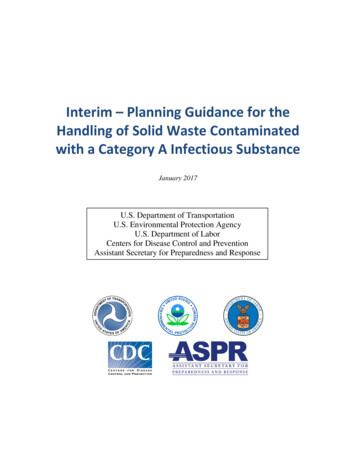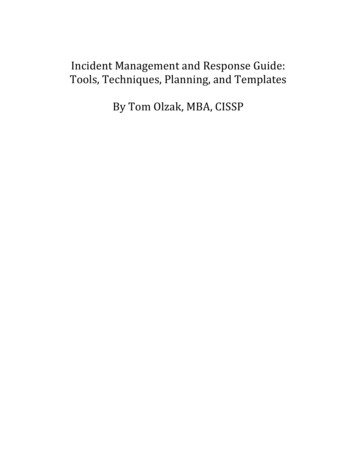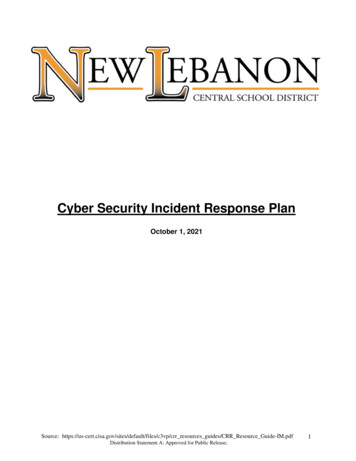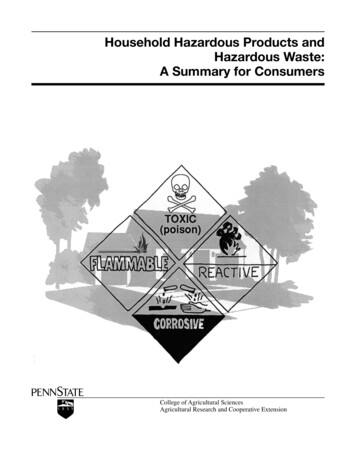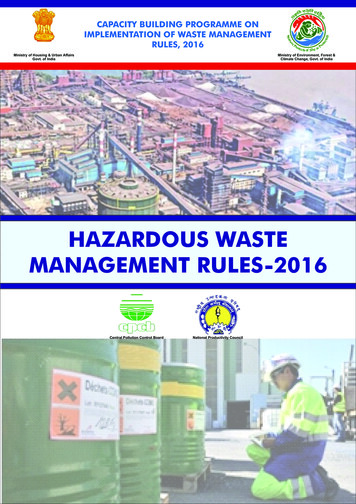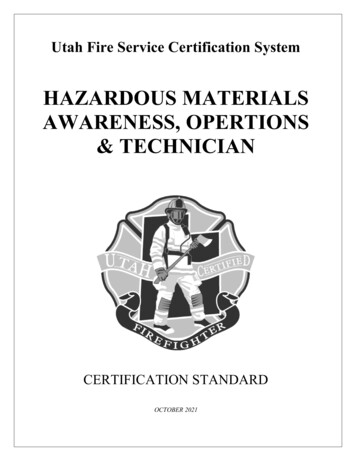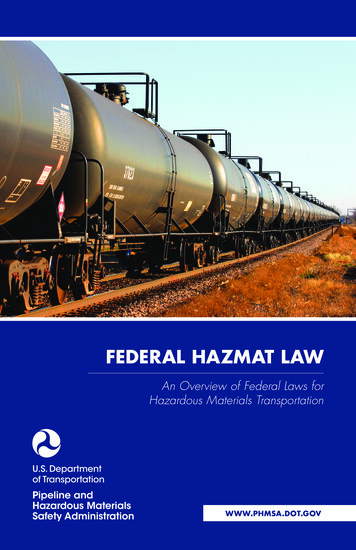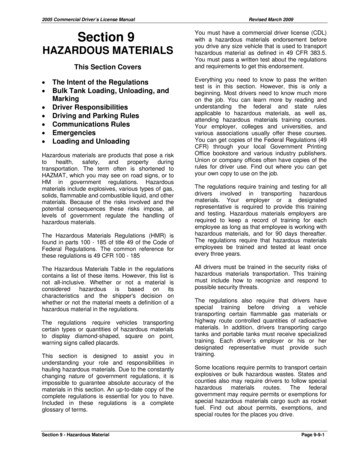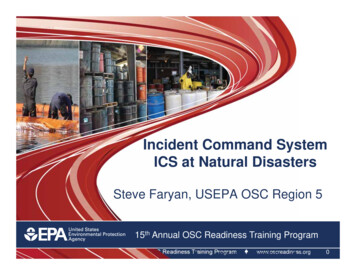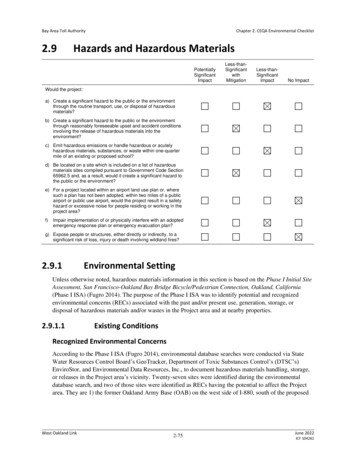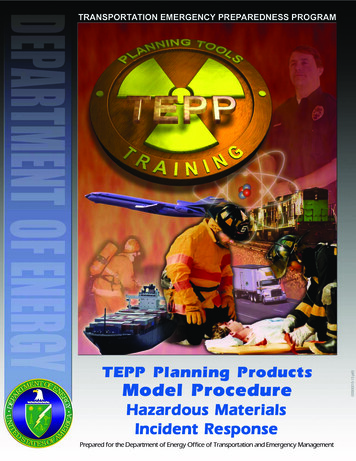
Transcription
Model ProcedureHazardous MaterialsIncident ResponsePrepared for the Department of Energy Office of Transportation and Emergency Management02B00215-13.p65TEPP Planning Products
planning toolstable ofcontentsTransportation Emergency Preparedness Program (TEPP)Hazardous Materials IncidentHazardousResponse ProcedureProcedurocedureAssumptions . 21.0Purpose . 22.0Scope . 23.0Responsibilities . 34.0Records . 35.0Frequency . 36.0References . 47.0Equipment . 48.0Location . 49.0Safety . 410.0 Terms/Definitions . 511.0 Planning and Coordination. 812.0 Site Security, Control, and Communications . 1013.0 Roles, Responsibilities, and Authority . 1114.0 Incident Objectives . 1115.0 Emergency Recognition and Prevention . 1116.0 Safe Distances and Refuge . 1217.0 Communications . 1518.0 Medical Plan . 1519.0 Emergency Alerting, Evacuation Routes, and RefugeProcedures . 1620.0 Decontamination . 1721.0 Dosimeter Readings . 1822.0 Comments . 1823.0 Signatures . 1924.0 Critique of Response and Follow-up Items . 201
Transportation Emergency Preparedness Program (TEPP)planning toolsREV 6 – 01/2007Hazardous Materials Incident Response ProcedureHazardousProcedurocedureThis Transportation Emergency Preparedness Program (TEPP) Hazardous Materials IncidentResponse Model Procedure contains the recommended actions for response totransportation incidents involving radioactive materials.ASSUMPTIONSThe following assumptions are to be considered when reviewing this procedure: This procedure is not all-inclusive but was developed to meet the minimum nationalstandards for response to a hazardous materials incident. This procedure is designed for use by trained and qualified emergency responders tooperate within the guidelines of OSHA’s 29 CFR 1910.120. Additional proceduralrequirements may be implemented according to the appropriate state, tribal, or localstandards. Response to transportation accidents involving radioactive materials should bemanaged as a response to a non-radioactive material hazardous material incident withadditional actions and precautions implemented as necessary due to the radiologicalconcerns. The response procedure should be utilized appropriately according to the conditionsencountered when arriving at these incidents. All emergency response personnel have been trained in the use of a national incidentmanagement system. Incident scene decisions regarding operations in the hot zone shall be approved bythe federal, state, tribal, or local agency or official designated as the RadiationAuthority.1.0PURPOSEThe purpose of this procedure is to provide guidance for developing an emergency responseplan, as outlined in OSHA’s 29 CFR 1910.120(q), for facility response. This model has beenadopted and applied to work for response to transportation accidents involving radioactivematerial or other hazardous materials incidents.2.0SCOPEThis procedure applies to those personnel who have responsibilities listed in Section 3.0.Furthermore, this procedure is intended for use on any response involving actual orpotential radiological or other hazardous material release.2
Transportation Emergency Preparedness Program (TEPP)REV 6 – 01/2007planning toolsHazardous Materials Incident Response ES3.1 Emergency Communications Center shall:3.1.1Notify Hazardous Materials Response Team (HMRT) Senior Officer andteam members of the accident and dispatch equipment as required.3.1.2Record information as required by the Emergency Communications CenterSpill Response Report Forms/Procedures.3.2 HMRT Senior Officer shall:3.2.1Contact shipper and carrier representatives.3.2.2Complete Hazardous Materials Data Sheet. (See Attachment B)3.2.3Consult with shipper, carrier representatives, Local Fire Department andState Radiation Control Division or Environmental Protection Division toreview proposed actions.3.2.4Identify and direct isolation plans.3.2.5Decide cleanup plan or request a private clean up contractor from the Stateapproved list.3.2.6Give proper turnover if a Contractor Spill Response Team is requested.3.2.7Communicate with appropriate agencies concerning incident status.3.2.8Be responsible for completion of all incident documentation.3.3 Emergency Medical Service personnel shall:3.3.1Monitor HMRT member’s vital signs prior to entry into hazardousenvironment.3.3.2Monitor HMRT team member’s vital signs upon exiting hazardousenvironment.3.4 Incident Commander shall:4.03.4.1Ensure completion of Scene Safety Plan any time entry work isnecessary.3.4.2Ensure completion of this procedure.RECORDS4.1Scene Safety Plan.4.2See attachments, this procedure:Attachment A - Hazardous Materials Incident Report FormAttachment B - HMRT Hazardous Material Data SheetAttachment C - HMRT Hazardous Materials Medical Surveillance Report5.0FREQUENCYUse this procedure as needed.3
planning toolsTransportation Emergency Preparedness Program (TEPP)REV 6 – 01/2007Hazardous Materials Incident Response .1NFPA 472 (2002) - Standard for Professional Competence of Responders toHazardous Materials Incidents6.2NFPA 473 (2002) – Standard for Competencies for EMS Personnel Responding toHazardous Materials/Weapons of Mass Destruction Incidents6.310 CFR 835.1302 - Emergency Exposure Situations6.429 CFR 1910.120 - Hazardous Waste Operations and Emergency Response6.5DOT Emergency Response Guidebook6.6U.S. Environmental Protection Agency - Standard Operating Safety Guide6.7International Association of Firefighters - Training for Hazardous MaterialsEmergency Response6.8MSDS Pocket Dictionary - JJ Keller 19986.9Transport of Radioactive Materials Q&A -Oak Ridge Associated Universities6.10Guidance for Developing State, Tribal and Local Radiological EmergencyResponse Planning and Preparedness for Transportation Accidents - FederalEmergency Management Agency - 19926.11National Incident Management System (NIMS)EQUIPMENTHazardous materials response equipment as determined by nature and scope of incident.8.0LOCATIONUse this procedure as needed based upon incident location.9.04SAFETY9.1Work within safety guidelines as specified in reference manuals.9.2Involve appropriate shipper, carrier, federal, state, tribal or local officials toassist in incident evaluation.9.3The Safety Officer designated by the Incident Commander on the scene has theauthority to stop any work in which safety related items may be an issue.9.4Report all injuries or unusual incidents to the Safety Officer or IncidentCommander.
REV 6 – 01/2007Transportation Emergency Preparedness Program (TEPP)planning toolsHazardous Materials Incident Response ProcedureHazardousProcedurocedure10.0 TERMS/DEFINITIONSBuddy System - a method of organizing employees into work groups in such a manner thateach employee of the work group is designated to be observed by at least one other employeein the work group. The purpose of the buddy systems to provide rapid assistant to employeesin the event of an emergency.CFR - Code of Federal Regulations - A collection of the regulations established by law. Contactthe agency that issued the regulation for details, interpretations, etc.Cold Zone - Also referred to as the support zone, the cold zone is a contamination-free zoneestablished around the warm zone where emergency operations can be directed and supported.The cold zone is normally established in an area where radiation levels are at natural backgroundlevels.Control Zones - The areas at a hazardous materials incident that are designated based uponsafety and the degree of hazard. Many terms are used to describe the zones involved in ahazardous materials incident. For the purposes of this document, these zones are defined asthe hot, warm and cold zones.Decontamination (Contamination Reduction) - The physical and/or chemical process ofreducing and preventing the spread of contamination at a hazardous materials incidentDOE – U.S. Department of Energy.Dose - A general term for the quantity of radiation energy absorbed.Dosimeter – A small portable instrument (such as a film badge, thermoluminescent or pocketdosimeter) for measuring and recording the total accumulated personnel dose of ionizing radiation.Dose Rate - The radiation dose delivered per unit time. For example, rem or millirem per hour(r/hr or mrem/hr). The dose rate is commonly used to indicate the level of hazard from aradioactive source.DOT – U.S. Department of Transportation.EPA – U.S. Environmental Protection Agency.ERG - Emergency Response Guidebook - Booklet that provides guidance during the initialphases of transportation emergencies involving hazardous materials.Exposure - Being exposed to ionizing radiation, radioactive material, or other hazardous materials.Radiation exposure is measured in Roentgens (R) or the subunit milliroentgens (mR). For practicalpurposes, one roentgen is equal to one rem.Hazardous Material - A substance capable of creating harm to people, the environment andproperty.HMRT - Hazardous Materials Response Team - an organized group of employees, designatedby the employer, who are expected to perform work to handle and control actual or potential leaksor spills of hazardous substances requiring possible close approach to the substance. The team5
planning toolsTransportation Emergency Preparedness Program (TEPP)REV 6 – 01/2007Hazardous Materials Incident Response ProcedureHazardousProceduroceduremembers perform responses to releases or potential releases of hazardous substances for thepurpose of control or stabilization of the incident. A HAZMAT team is not a fire brigade nor is atypical fire brigade a HAZMAT team. A HAZMAT team, however, may be a separate component of afire brigade or fire department.Hot Zone - Also referred to as the exclusion zone in some jurisdictions. The hot zone isusually set up in the immediate area surrounding the spilled material or incident scene. Accessto the hot zone should be controlled for accountability purposes as well as contaminationcontrol purposes.IC - Incident Commander - The person responsible for all decisions relating to the managementof the incident. The incident commander is in charge of the incident scene. This term is equivalentto the on-scene incident commander.ICS - Incident Command System - An organized approach to control and manage operations atan emergency incident. The OSHA Hazardous Waste Operations and Emergency Responseregulations (29 CFR 1910.120 (q) (3) (ii) require that an ICS be implemented by the senioremergency response official on the scene).LEL - Lower Explosive Limit - Refers to the lowest concentration of gas or vapor (% by volumein air) that burns or explodes if an ignition source is present at ambient temperatures.Monitoring Equipment - Instruments and devices used to identify and quantify contaminants.MSDS - Material Safety Data Sheet - A fact sheet summarizing information about materialidentification; hazardous ingredients; health, physical, and fire hazards; first aid; chemicalreactivities and compatibilities; spill, leak and disposal procedures; and protective measuresrequired for safe handling and storage.National Incident Management System (NIMS) - A comprehensive, national approach to incident management applicable to all jurisdictional levels.NFPA - National Fire Protection Association- An international voluntary membershiporganization formed to promote/improve fire protection and prevention and establish safeguardsagainst loss of life and property by fire.NIOSH - National Institute of Occupational Safety and Health.OSHA - Occupational Safety and Health Administration - The U.S. Department of Labor’sregulatory and enforcement agency for safety and health.PPE - Personal Protective Equipment includes both respiratory and physical protection. Onecannot assign a level of protection to clothing or respiratory devices separately. These levelswere accepted and defined by response organizations such as U. S. Coast Guard, NIOSH, andU.S. EPA.6Level A:Self Contained Breathing Apparatus (SCBA) plus fully encapsulatingchemical resistant clothing (permeation resistant)Level B:Self Contained Breathing Apparatus (SCBA) plus chemical resistant clothing(splash proof)
REV 6 – 01/2007Transportation Emergency Preparedness Program (TEPP)planning toolsHazardous Materials Incident Response ProcedureHazardousProcedurocedureLevel C:Full or half-face respirator plus chemical resistant clothing (splash proof)Level D:Coverall with no respiratory protection.Radiation Authority - A federal, state, or tribal agency designated official. Responsibilitiesinclude evaluating radiological hazard conditions during normal operations and emergencies.Radioactive Material LabelsRadioactive White-I – applied to packages with a surface dose rate of equal to or lessthan 0.5 millirem/hr.Radioactive Yellow-II - applied to packages with a surface dose rate of equal to or lessthan 50 millirem/hr or equal to or less than 1 millirem/hr at 1 meter.Radioactive Yellow-III - applied to packages with a surface dose rate of equal to orless than 200 millirem/hr or equal to or less than 10 millirem/hr at 1 meter.Radioactivity - The spontaneous emission of radiation, generally alpha or beta particles, oftenaccompanied by gamma rays, from the nucleus of an unstable atom or radioisotope (see below).Also, the rate at which radioactive material emits radiation.Radioisotope (radionuclide) - An unstable isotope of an element that decays or disintegratesspontaneously, emitting radiation. Approximately 5,000 natural and artificial radioisotopes havebeen identified.Rem - The acronym for Roentgen Equivalent Man is a standard unit that measures the effects ofionizing radiation on humans.UEL - Upper Explosive Limits - The highest concentration of a material in air that produces anexplosion or fire or that ignites when it contacts an ignition source.Warm Zone - Also referred to as the contamination reduction zone, the warm zone is usuallyestablished around the hot zone to provide a buffer between the hot and cold zones.Decontamination often takes place in the warm zone.7
planning toolsTransportation Emergency Preparedness Program (TEPP)REV 6 – 01/2007Hazardous Materials Incident Response ProcedureHazardousProcedurocedure11.0 PLANNING AND COORDINATIONWhen notified of a radioactive material or other hazardous materials incident by the EmergencyCommunications Center, the HMRT senior officer shall request and record all pertinentinformation as obtained by Emergency Communications Center on the Hazardous MaterialsIncident Report Form (see Attachment A).Upon arrival at incident scene, the HMRT senior officer is to: Report to the Incident CommandPost and receive an incident briefing from the Incident Commander using/completing the attachedICS Form 201. The Incident Commander also has the responsibility to complete an incidentorganization chart using the attached ICS Form 207.Verify initial responders using the Emergency Response Guidebook appropriately identifiedand implemented recommended ERG protective actions.Request Shipping/MSDS Papers from the Incident Commander or transporting carrierrepresentative.Complete the HMRT Hazardous Materials Data Sheet to assist in scene assessment. (SeeAttachment B.)Upon completion of Data Sheet, the HMRT senior officer is to consult with federal, state, tribaland/or local agencies on scene to review proposed actions.Based on the IC’s decision, if the Hazardous Materials Response Team is to be assigned toresponse duties for a long duration, the IC will request mutual aid from state, tribal, local orprivate response agencies. If the incident exceeds HMRT capabilities, the following agenciescan be contacted for assistance: Local Emergency Response Support County Emergency Management Division Local Mutual Aid Emergency RespondersThis portion of the Hazardous Materials Response procedure shall be filled out prior to HMRTentry and shall be updated as necessary during the course of the incident. AppropriateAttachments shall be completed as required.Date of Plan TimeVerify: Initial emergency responders have implemented appropriate actions as indicated bythe Emergency Response Guidebook and that incident scene has been re-evaluated forchanging conditions or additional hazards.Identify or list mutual aid or support agencies participating in the response.8
REV 6 – 01/2007Transportation Emergency Preparedness Program (TEPP)planning toolsHazardous Materials Incident Response ProcedureHazardousProcedurocedureNOTE: Communications with the State Emergency Response vehicle can be established byobtaining cellular phone number from the agency.Include names, addresses and telephone numbers local, state or tribal radiation authoritieshaving responsibility for emergency response and/or assistance.Local, State or Tribal Contact forRadioactive Materials ResponseMailing Address24-Hour Telephone9
planning toolsTransportation Emergency Preparedness Program (TEPP)REV 6 – 01/2007Hazardous Materials Incident Response ProcedureHazardousProcedurocedure12.0 SITE SECURITY, CONTROL, AND COMMUNICATIONSControl boundaries (hot zone, warm zone, and cold zone) for the incident shall be established.Use the attached ICS Form 201 to develop a map/sketch prior to the initial HMRT entry. Themap/sketch should include the following information. Identification of map north Wind direction Command Post Staging Area Rehab Area Access Control points Contamination reduction line Drainage points Natural and manmade topographic features including locations of buildings, containers,impoundments, pits, ponds, tanks or any other scene features.Update incident scene maps as necessary to reflect changing conditions or new information.Boundaries identified by:Person designated to coordinate scene access:NOTE: Only authorized personnel shall be allowed within the incident area. Qualifications forentry include training and medical monitoring according to OSHA 29 CFR 1910.120.Command Post locationStaging locationRehab locationWind Direction & Conditions10
Transportation Emergency Preparedness Program (TEPP)REV 6 – 01/2007planning toolsHazardous Materials Incident Response ProcedureHazardousProcedurocedureNOTE: The Command Post, Staging Area and Rehab Area are to be located upwind from theexclusion area.Listing of established law enforcement/security boundariesHave law enforcement/security provide a map indicating location of established boundariesfor the incident. These areas shall be identified on an attached map or drawn on page 17.13.0 ROLES, RESPONSIBILITIES, AND AUTHORITYIncident Operations List: List the person(s) responsible for each job function on the attachedICS Form 203.14.0 INCIDENT OBJECTIVESList incident objectives using the attached ICS Form 202 and name assignments for each teamusing ICS Form 204. All personnel shall be briefed on communication methods, emergencyevacuation, event status, product hazards, personal protective equipment required, overallobjectives and on their specific job functions.15.0 EMERGENCY RECOGNITION AND PREVENTIONHazard Evaluation: List all known or suspected hazardous substances and concentrationssuspected to be on-scene. Identify the primary hazard of each.NOTE: The Hazardous Material Data Sheet (Attachment B) should be completed for eachhazardous substance listed below.ProductConcentrationPrimary Hazard/ // // // // /11
planning toolsREV 6 – 01/2007Transportation Emergency Preparedness Program (TEPP)Hazardous Materials Incident Response ProcedureHazardousProcedurocedurePersonal Protective EquipmentList specific Personal Protective Equipment (PPE) requirements as recommended by referencematerial and/or MSDS:ProductPPE RequirementWhen determining level of personal protective equipment for response to radiologicalhazards, utilize Emergency Response Guidebook guides 161-166, the MSDS, and/orinformation provided by shipper.16.0 SAFE DISTANCES AND REFUGEUpon evaluation of known and suspected potential hazards, personal protective equipmentshall be selected and documented below:LocationHot Zone (Exclusion)Warm Zone (Decon)12Job FunctionLevel of ProtectionABC DOtherAB C DOtherABC DOtherABC DOtherABC DOtherABC DOtherABC DOtherABC DOther
REV 6 – 01/2007Transportation Emergency Preparedness Program (TEPP)planning toolsHazardous Materials Incident Response ProcedureHazardousProcedurocedureCold Zone (Support)ABC DOtherABC DOtherNOTE: Only the Incident Commander or the Safety Officer has the authority to change thetype of personal protective equipment to be used during the incident.Incident Scene MonitoringMonitoring for hazardous atmospheres should be used in establishing the Command Postlocation. The Command Post should be continuously monitored for hazardous atmospheres.Incident scene monitoring must be conducted during initial and subsequent entries. Ifconversion factors are used, the conversions should be conducted by the Science Officer andthen relayed to the Incident Commander and Operations Officer.List the monitoring instrument(s) used and conversion factors or calibration information asreflected by the manufacturer’s literature or procedure:InstrumentConversion factorCalibrated to/ // // /Command Post Atmospheric Monitoring ResultsTimeO2 %CGI%Radiation Survey/ / // / // / // / /The following action levels are provided as EPA recommendations:Oxygen Indicator: 19.5% - Monitor using SCBA 25% - Discontinue monitoring; fire hazard potential13
planning toolsTransportation Emergency Preparedness Program (TEPP)REV 6 – 01/2007Hazardous Materials Incident Response ProcedureHazardousProcedurocedureCombustible Gas Indicator (CGI): 10% - LEL Continue monitoring with caution10-25% - LEL Continue monitoring with extreme caution as higher levels are encountered 25% - LEL Explosion hazard; withdraw from area immediatelyRadiological Conditions:See below for emergency exposure guidelines and stay time table.G ui de l i ne s f o r C o nt ro l o f Eme rg e nc y Ex po s ure sD o s e L i mi t (re m)A c t i vi t y P e r f o r m e d5 re mA ll1 0 re mP r o te c ti o n o f m a jo r p r o p e r tyW he r e l o w e r d o s e l i m i t i s no tp r a c ti c a b le2 5 re mL i f e s a vi ng o r p r o t e c t i o n o fl a r g e p o p ul a t i o nsW he r e l o w e r d o s e l i m i t i s no tp r a c ti c a b le 2 5 re mL i f e s a vi n g o r p r o t e c t i o n o fl a r g e p o p ul a t i o nsO n l y o n a vo l u n t a r y b a s i s t o p e r s o n n e lf u l l y a w a r e o f t h e r i s k s i n vo l ve dGammaRadiationDos e RateRate /hour14C o nd i t i o nStay Time to Re ce ive This Radiation Dos e1 re m5 re m10 re m25 re m100 re m1mR/hour6 weeks30 weeks1 year5 mR/hour200 hours6 weeks12 weeks30 weeks2 years100 mR/hour10 hours50 hours100 hours250 hours6 weeks1 R/hour1 hour5 hours10 hours25 hours100 hours10 R/hour6 minutes30 minutes1 hour2.5 hours10 hours100 R/hour36 seconds3 minutes6 minutes15 minutes1 hour200 R/hour18 seconds1.5 minutes3 minutes7.5 minutes30 minutes500 R/hour7 seconds36 seconds72 seconds3 minutes12 minutes
REV 6 – 01/2007Transportation Emergency Preparedness Program (TEPP)planning toolsHazardous Materials Incident Response ProcedureHazardousProcedurocedureRefugeAll responders should be briefed on designated refuge locations. Typically these include upwindlocations. Refuge may be required for severe weather, unexpected conditions, or eventescalation. See Section 16 on Emergency Evacuation Routes, Refuge, and Procedures for specificguidance.17.0 COMMUNICATIONSAll personnel involved in entry team activities shall remain in constant communication—viaradio, visual, or verbal methods—with the IC or his designee (HMRT Operations Officer, SafetyOfficer, etc.). Failure of communication requires the entry team to exit the hot zone.Reference Section 19.0 for emergency alerting procedures and signals to indicate when personnelshould exit the hot zone.Identify communication methods available to the Command Post:Cellular Phone Numbers//FAX Numbers//Communications information should be documented on the Incident Radio CommunicationsList - ICS Form 205 (see attachments) and on the Radio Requirement Worksheet - ICS Form 216(see attachments).18.0 MEDICAL PLANEstablish a Medical Plan using the attached ICS Form 206. The plan should document the nameand location of nearest medical facility. Use the Hazardous Materials Medical Surveillance Report(Attachment C) to document responder pre and post entry medical conditions.15
planning toolsTransportation Emergency Preparedness Program (TEPP)REV 6 – 01/2007Hazardous Materials Incident Response ProcedureHazardousProcedurocedure19.0 EMERGENCY ALERTING, EVACUATION ROUTES, ANDREFUGE PROCEDURESThe following standard emergency procedures will be used by on-scene personnel. The SafetyOfficer shall be notified of ANY on-scene emergencies and will be responsible for ensuring thatthe appropriate procedures are followed.Responder Emergency Alerting SignalsThe following hand signals shall be used in by responders in case of radio failure:Hands gripping throatGrip partner’s wristHands on waistHands on top of headThumbs upThumbs downOut of air/Breathing difficultyLeave area immediatelyLeave area immediatelyNeed assistanceI’m OK/I understandI’m not OKUncontrolled Fire/Explosion Alerting ProcedureIncident Commander, using radio and public address, will announce to all involved in thearea to evacuate. Air horns on emergency response vehicles will sound with three blasts toindicate emergency evacuation.Personal Protective Equipment Failure ProcedureIf any responder experiences a failure or alteration of the PPE, that person AND his/herbuddy shall immediately exit the hot zone. Re-entry shall not be permitted until theequipment has been properly repaired or replaced. The “buddy system” shall be used at alltimes.Other Equipment Failure ProcedureIf any other equipment on the incident scene fails to operate properly, the IncidentCommander and the Safety Officer shall be notified and shall then determine the effect thisfailure has on continuing operations. If the failure affects the safety of personnel or preventscompletion of the Entry Objectives, all personnel shall leave the hot zone until the situationis evaluated and appropriate actions are taken.Emergency Evacuation Routes and Refuge:The following routes shall be designated for exit from the hot zone in case egress cannotoccur through the established decon area.16
REV 6 – 01/2007Transportation Emergency Preparedness Program (TEPP)planning toolsHazardous Materials Incident Response ProcedureHazardousProcedurocedureThe following area shall be the designated area for personnel refuge in the event of severeweather, unexpected conditions, or event escalation.In all situations, when an incident scene emergency results in evacuation of the hot zone,personnel do not re-enter until: The conditions resulting in the emergency have been corrected. The hazards have been reassessed. The Scene Safety Plan has been reviewed. Scene personnel have been briefed on any changes in the Scene SafetyPlan.20.0 DECONTAMINATIONA Decontamination Plan should be established during the hazard evaluation process. Alldecontamination requirements should be documented below:Decon SetupEmergency decon shall include the following:Decon Equipment requiredDecon solutionSuit Journal ReportRecord necessary information as may be required by suit manufacturer to document productexposed to, length and type of exposure and decon solution17
planning toolsREV 6 – 01/2007Transportation Emergency Preparedness Program (TEPP)Hazardous Materials Incident Response ProcedureHazardousProcedurocedure21.0 DOSIMETER READINGSDocument readings from dosimeters in the section noted below.Dosimeter Scale (e.g., 0 to 200 mR)Responder NameDateTimeDosimeterSerial No.InOutDosimeterReadingInTotalDoseOut22.0 COMMENTS18
REV 6 – 01/2007Transportation Emergency Preparednes
Emergency Management Agency - 1992 6.11 National Incident Management System (NIMS) 7.0 EQUIPMENT Hazardous materials response equipment as determined by nature and scope of incident. 8.0 LOCATION Use this procedure as needed based upon incident location. 9.0 SAFETY 9.1 Work within safety guidelines as specified in reference manuals.
